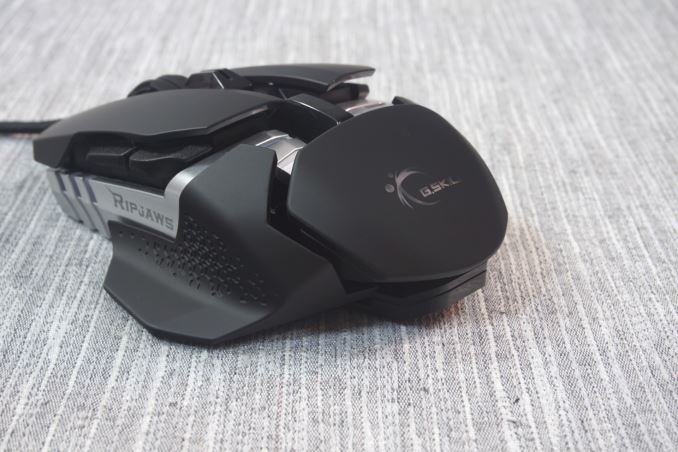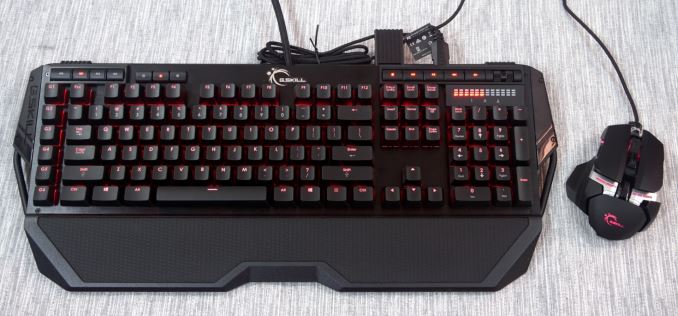The G.Skill KM780 Mechanical Keyboard & MX780 Gaming Mouse Review
by E. Fylladitakis on November 4, 2015 8:00 AM EST- Posted in
- G.Skill
- Peripherals
- Mouse
- Cherry MX
- Mechanical Keyboards
Conclusion
Let's begin our conclusion with our thoughts on the KM780 RGB mechanical keyboard. The primary selling factor of this keyboard undoubtedly is quality and the KM780 RGB truly is one of the highest quality keyboards we have ever tested. The Cherry MX RGB keys are, as with all of the keyboards that we tested to this date, very stable and consistent. There is virtually no key wobbling or any feeling of ricketiness about the keyboard, including the buttons across the top, which offer great tactile feedback.
The design of the Ripjaws KM780 could be improved. Aesthetics are a strongly subjective matter and thus some will enjoy the modern appearance of the KM780 while others might hate it. However, the design also affects the functionality of a keyboard. The plastic side flaps and metallic tube unnecessarily add to the width of the keyboard, taking up desktop space and pushing the mouse pad further to the right. This can be a deal breaker for some gamers, especially those seeking narrow (or even tenkeyless) designs to keep the mouse as close to their front as possible. The metallic tube adds some functionality, as the cable holder and the keycaps container attach to it, but it could just stop at the edge of the keyboard and not run across the sides as well.
Another issue would be the backlighting of the extra buttons and the LED indicator bar. The Cherry MX RGB switches are excellent and the software offers enough programming options, but the inability to change the backlighting of the extra buttons is problematic. With the keyboard switched to any other color than red, the red color of the buttons is a major visual dissonance. RGB LEDs ought to have been installed beneath these buttons as well.
The G.Skill KM780 RGB mechanical keyboard is clearly designed to compete against the best gaming keyboards currently available. Specifically, taking into account its design and the use of Cherry MX RGB switches, it seems as if G.Skill attempts to take a piece of Corsair's pie. G.Skill's KM780 RGB is a bridge between the "plain" Corsair K70 RGB and their "overloaded" K95 RGB, offering the few extra macro keys, dedicated mode/profile switching keys and USB/audio pass-through connectors that the K70 RGB is missing. In terms of quality, G.Skill would have no problem competing with Corsair, and aesthetics are a subjective matter.
The Unified Driver System software however needs a lot of work before it can be even considered as a competitive solution against Corsair's Utility Engine. We are still at version 0.62 and, if G.Skill places some effort and resources on this, it could be greatly improved soon. Still, truth be told, virtually only Corsair currently has a significantly better software package, as most other manufacturers have also neglected upgrading their own software packages.
As for the MX780 gaming mouse, that is an entirely different story. Although the Ripjaws MX780 mouse also sports a modern design as well, it is not really a matching design next to the KM780 mechanical keyboard. Then again, G.Skill never claimed that these two products are a set and they are being sold separately. It also has a far broader range of direct competitors, unlike the KM780 that essentially competes against half a dozen other products at most.
The main selling points of the mouse remain the quality and good gaming performance. After using the mouse alongside the keyboard for two weeks, I cannot say that the quality and feel of it is less than excellent. Even though the design favors users accustomed to a palm grip and I am strongly used to a claw grip, I had no issues working with the Ripjaws MX780 and adapted to its design in virtually a few minutes. With a claw grip, I had easy access to two of the side buttons using my thumb, as well as one of the other side buttons using my ring finger, while my pinky was maintaining gliding balance. Trying to access both of the right side buttons with my ring finger however was nearly impossible without losing the balance of my grip.
As for the software, it definitely would benefit from a more sophisticated macro recorder, just like the keyboard. However, complex macros are not as important on a mouse. Most users will just remap the side buttons to perform a single function, such as to throw a grenade, take out the flashlight, or drink a potion. Even for professional use, the side mouse buttons are usually reprogrammed to Windows commands, such as Copy and Paste. As such, although the software can be improved, it is passable for use with the mouse.
As with all such designs, having a single button and rotating DPI settings is not very practical. If you are using more than two DPI settings, it can be very confusing, especially in fast-paced games. I do not personally use more than just one DPI setting, so I repurpose the DPI selection button to something else. Besides, for aiming, it would probably work a lot better if one of the thumb buttons is set to activate the "sniper" mode while pressed. Finally, the presence of RGB lighting has some aesthetic value but, in my opinion, no practical value whatsoever. Even if someone has to look at the mouse for visual feedback, i.e. check the selected mode or DPI setting, most of the LEDs are beneath the palm and cannot be easily discerned. Taking your hand off the mouse would be catastrophic in all but the most slow-paced games and, even then, having to look at the mouse is not a practical way to receive feedback.
In conclusion, much like every product, both of the Ripjaws KM780 mechanical keyboard and the MX780 gaming mouse have both advantages and disadvantages. The KM780 RGB and the MX780 are currently retailing for $160 and $60 respectively, in good agreement with their direct competition. For example, the two main competitors of the KM780 RGB mechanical keyboard, Corsair's K95 RGB and K70 RGB keyboards, currently retail for $180 and $170 respectively. G.Skill's products are not significantly less expensive but are of equivalent quality and performance. The software should be improved and the inability of the media/extra keys to change their backlighting color is a visual dissonance on a RGB keyboard, but they are high quality products. Their features and design should be considered and weighted against the individual needs by each user that is shopping for a high quality mechanical keyboard and gaming mouse.














33 Comments
View All Comments
gregounech - Wednesday, November 4, 2015 - link
These things look terrible. And probably are POS.gregounech - Wednesday, November 4, 2015 - link
Also please, stop testing mouse without giving us any information about the sensor and how it performs.nikon133 - Wednesday, November 4, 2015 - link
"...Avago ADNS 9800 laser sensor is mounted on. This sensor is found on almost every high performance laser gaming mouse available today".Well that's some sensor info, at least...
SilthDraeth - Friday, November 6, 2015 - link
The Avago ADNS 9800 has acceleration built in. Most people that want high end gaming mice want a sensor that has no acceleration. Unless something has changed with the sensor.zeeBomb - Wednesday, November 4, 2015 - link
What's the best mechanical keyboard to get depending on the price range? In 3 categories:Low
Medium/ Standard
High-end
As much as I love blues, browns are going to be my next approach. Any feedback is greatly appreciated.
RaichuPls - Wednesday, November 4, 2015 - link
For low end, I recommend a CM Storm Quickfire TK. It's a good quality solidly built keyboard, with a numpad in a tenkeyless form factor.zeeBomb - Wednesday, November 4, 2015 - link
Good stuff y'all. I heard Razer switches uses some Chinese version of cherry switches, and albeit being good the longevity is questionable.Stuka87 - Wednesday, November 4, 2015 - link
I prefer Razer's stealth keyswitches to any of the Cherries that I have used.Alexvrb - Wednesday, November 4, 2015 - link
The switches the Stealths use are pretty similar to Cherry MX Brown IIRC.techfreshness - Friday, November 6, 2015 - link
yep, the oranges are 'similar' to the browns, greens 'similar' to the blues, but the razer switches do have important differences